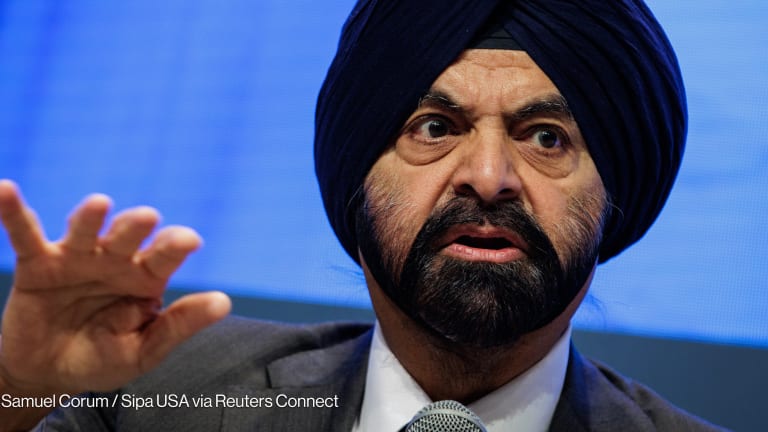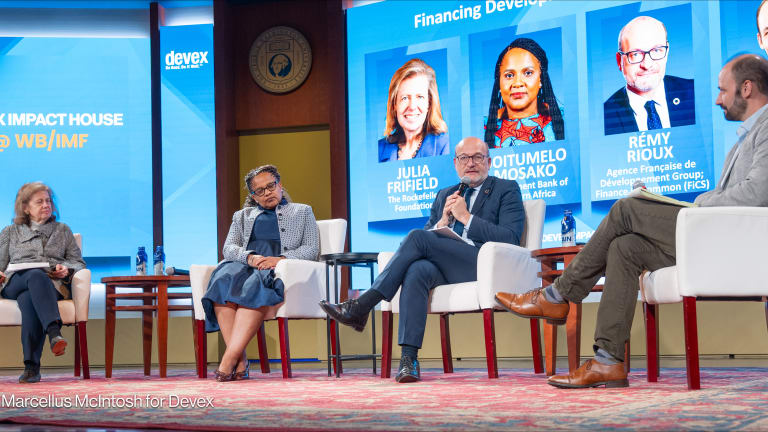
New players, new partners and new relationships were the talk of the Society for International Development World Congress in Washington this weekend.
The new players are corporations, which have learned that – while old-fashioned philanthropy can be a public relations boon – capacity building in impoverished nations not only opens up new markets but also makes a much bigger difference in peoples’ lives.
The new partners are citizens of recipient nations who are taking a more active role in deciding where and how donor dollars ought to be spent. And the new relationships are links being forged by the traditional development community, which is learning to leverage a small amount of startup aid into major investments by the private sector and major opportunities for entrepreneurs in the developing world.
“Private capital investment is correlated with reductions in poverty and with increases in living standards,” Elizabeth Littlefield, president of the Overseas Private Investment Corp., said at one of the conference’s panel discussions.
“The private sector creates 90 percent of the jobs in emerging markets and most of the things people want, like cell phones and cold storage and roads,” she continued. “But for some reason, the development community has traditionally split itself off from the private sector and thought of itself as only [official development assistance] and government-to-government assistance. Those days are over.”
The Society for International Development, founded in 1957, is one of the largest industry organizations for development practitioners. The 2011 World Congress was titled “Our Common Challenge: A World Moving Toward a Sustainable Future,” and focused on the way changes in the global landscape, including advances in science and technology and the American and European debt crises, are shaping how development is practiced. Devex was a media sponsor of the event.
Littlefield advocated for a development system similar to OPIC’s model. That independent U.S. government agency uses a small amount of startup capital to leverage private sector investment in a project with multiple companies each taking responsibility for a different piece of the pie, such as providing technical assistance or financing early operating losses.
Leveraging private-sector investment isn’t new for the development community, Littlefield said, but too often agencies put those networks of private-sector partners together on an ad hoc, project-by-project basis, negotiating a complex web of turf battles and culture clashes each time.
With a reliable back bench of existing private-sector partners, aid organizations can cut down both on their own investment in a project and on the amount of time and effort it takes to get a project off the ground, she said.
Public-private partnerships like those OPIC manages cash in on the corporate world’s already-strong drive to invest in emerging markets, and ensure those investments are made with adequate environmental and labor standards, Littlefield said. They’re also more sustainable than traditional aid from the U.S. and Europe, which are more focused on escaping from their own debt burdens now than on funding development abroad, she said.
For its part, the private sector has learned that capacity building and genuine technology transfer in developing nations ultimately improves its bottom line, Mamadou Beye, manager of international government relations at Chevron, said during a separate discussion, and that ignoring government corruption and inequalities of wealth does not.
“Nigeria was producing [oil] at half capacity for years because of unrest in the Delta,” Beye said. “You may have government permits, but if the community doesn’t see value, they won’t let you operate.”
Chevron pledged $25 million to development projects in the Niger Delta this year, part of a joint $50 million project with the U.S. Agency for International Development. The energy giant has funded similar development programs in other nations where it has large business interests.
USAID is using a microinvestment and leveraging model in its Development Innovation Ventures project, Susan Reichle, assistant to the administrator for the agency’s Bureau of Policy, Planning and Learning, said.
That project provides capital to promising development entrepreneurs at three different stages of the development process: initial development of a new product, testing the product and scaling the product so it can impact thousands of people or more. The agency also encourages recipients to use the USAID grant money to leverage private sector investments.
Some of the innovation ventures projects have relied on new technology, such as a mobile phone application that measures the levels of glucose and other elements in pregnant women’s blood to reduce infant mortality, Reichle said. Others aren’t technological at all, she said, such as picture books that teach illiterate women what to expect at each stage of pregnancy and during the first months of motherhood.
“Some of the best innovations are just practices that we all see at the community level that just need to be scaled up,” she said.
The American Islamic Congress mixes microgrants for North Africans who have ideas for civic projects with training in financing, organization and marketing, Dalia Ziada, director of the organization’s North Africa bureau, said. AIC’s idea, Ziada said, is that North African people themselves have the best ideas about how to build a thriving civil society and that development money is best spent on capacity building to help them put those ideas into practice.
AIC has traditionally focused on promoting moderation in the Muslim world and raising the profile and understanding of moderate Islam in the West, but has ramped up its development programming on the ground since the Arab Spring.
Littlefield allowed that there are some regions so racked by conflict or poverty that the public-private development model simply can’t function.
“There are always going to be intractable areas where there’s no commercial viability in the foreseeable future,” she said, “and that’s stuff that needs to be funded by the public sector. But the public sector shouldn’t be funding stuff that someone else can make a profit off of.”








